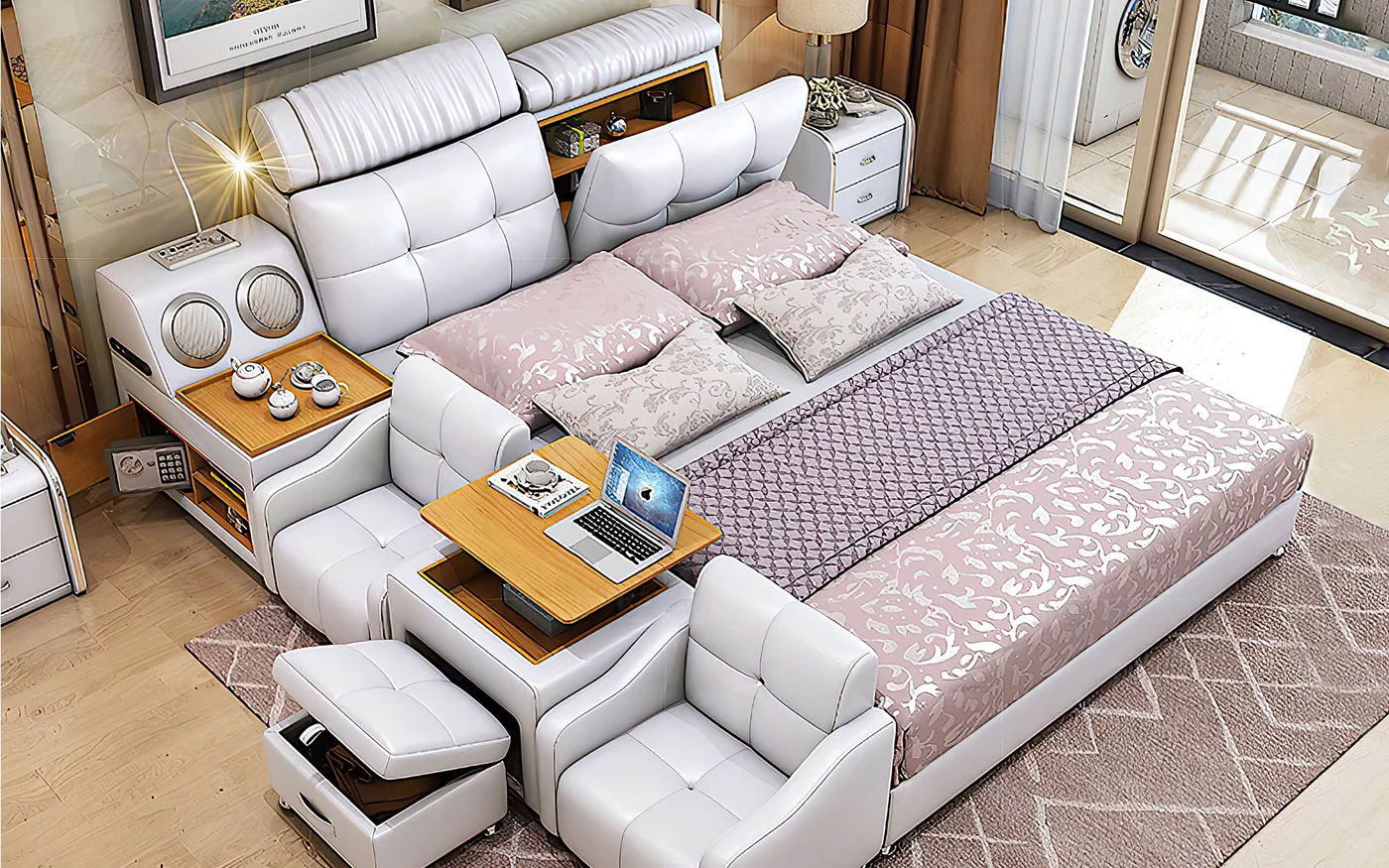Top 10 Alaskan King Bed Designs You’ll Love

Traditional Wooden Frame Beds
Traditional wooden frame beds are beloved for their timeless appeal, sturdy craftsmanship, and rich aesthetic. Here’s a detailed look at what makes traditional wooden frame beds a popular choice:
Design Characteristics:
- Material: Traditional wooden frame beds are typically crafted from high-quality woods such as oak, mahogany, cherry, or walnut. These woods are chosen for their durability, natural beauty, and ability to withstand years of use.
- Construction: The construction of traditional wooden beds often features solid wood frames that are robust and long-lasting. The joints are usually dovetailed or mortise-and-tenon for strength and stability.
- Headboard and Footboard: The headboards of traditional wooden beds can vary widely in design, from simple slats to intricate carvings or panel designs. Footboards may also feature matching designs or a simpler complement to the headboard.
- Finishes: These beds may be finished in natural wood tones to showcase the grain and texture of the wood, or they may be stained or painted to match various décor styles. Some designs incorporate distressed finishes for a more rustic look.
Styles:
- Classic: Classic designs feature straight lines and minimal ornamentation, emphasizing the natural beauty of the wood itself.
- Victorian: Victorian-style wooden beds often have elaborate carvings, curves, and intricate details on both the headboard and footboard, reflecting the opulence of the era.
- Mission: Mission-style beds feature simple, straight lines with slatted headboards and footboards, inspired by the Arts and Crafts movement, focusing on craftsmanship and functionality.
Benefits:
- Durability: Wooden frame beds are known for their durability and longevity.
- Timeless Appeal: The classic and versatile design of wooden frame beds complements various décor styles, from traditional to contemporary.
- Natural Aesthetic: Wood adds warmth and a natural element to the bedroom, creating a cozy and inviting atmosphere.
- Customization: Many traditional wooden beds offer customization options in terms of finishes, allowing you to match your bed to existing furniture or décor.
Considerations:
- Maintenance: Wooden beds may require occasional polishing or conditioning to maintain their luster and protect against wear.
- Weight: Solid wood frames can be heavy, so it’s important to ensure your floor can support the weight of the bed.
- Cost: Depending on the wood type and craftsmanship, traditional wooden frame beds can vary widely in price, from affordable options to high-end pieces.
Conclusion:
Traditional wooden frame beds are a popular choice for those who appreciate craftsmanship, durability, and timeless style. Whether you prefer a simple and classic design or a more elaborate Victorian style, these beds add a touch of elegance and warmth to any bedroom décor.

Upholstered Beds
Upholstered beds are known for their luxurious appearance, comfort, and versatility in bedroom decor. Here’s a detailed look at what makes upholstered beds a popular choice:
Design Characteristics:
- Upholstery Materials: Upholstered beds feature fabric or leather upholstery on the headboard, footboard, and sometimes the side rails. Common upholstery materials include:
- Fabric: Options range from linen and cotton to velvet and suede, offering a variety of textures and colors to suit different tastes.
- Leather: Genuine or faux leather adds a sleek and sophisticated look, with options like smooth or textured finishes.
- Frame Construction: The frame of an upholstered bed can vary from sturdy wood to metal. Wooden frames are often used for their durability and ability to support the weight of the upholstery.
- Headboard Styles: Upholstered beds come in various headboard styles:
- Panel: Upholstered panels are flush with the bed frame, creating a seamless and modern look.
- Tufted: Tufted headboards feature buttons or stitching that create a patterned design, adding depth and elegance.
- Wingback: Wingback headboards have side panels that extend slightly forward, providing extra comfort and a cozy feel.
Styles:
- Contemporary: Clean lines and minimalistic designs are common in contemporary upholstered beds, often with neutral colors or bold, contrasting fabrics.
- Traditional: Traditional upholstered beds may feature intricate detailing on the headboard and footboard, such as deep button tufting or decorative nailhead trim, reflecting classic elegance.
- Transitional: Blend elements of both contemporary and traditional styles, offering versatility that can complement various bedroom decor themes.
Benefits:
- Comfort: Upholstered beds provide a soft and comfortable surface to lean against while sitting up in bed, making them ideal for reading or watching TV.
- Versatility: The wide range of upholstery fabrics and styles allows upholstered beds to fit into any bedroom decor, from modern to traditional.
- Durability: High-quality upholstery materials and solid frame construction ensure longevity with proper care and maintenance.
- Noise Reduction: Upholstered beds tend to absorb sound better than metal or wooden beds, reducing noise from movement during sleep.
Considerations:
- Maintenance: Depending on the fabric or leather used, upholstered beds may require occasional vacuuming, spot cleaning, or professional cleaning to maintain their appearance.
- Cost: Prices for upholstered beds can vary widely based on the quality of upholstery materials, frame construction, and design complexity.
- Assembly: Some upholstered beds may require assembly upon delivery, particularly larger designs or those with intricate headboard styles.
Conclusion:
Upholstered beds offer a blend of style, comfort, and versatility that makes them a popular choice for bedroom furniture. Whether you prefer the modern simplicity of a panel headboard or the luxurious look of a tufted wingback design, upholstered beds provide a cozy retreat and enhance the overall ambiance of your bedroom.
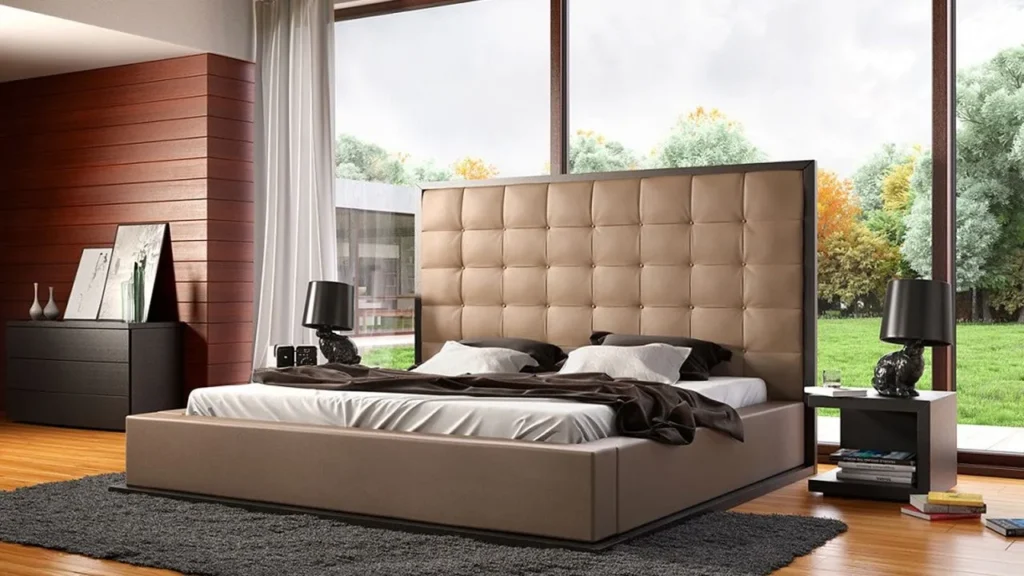
Rustic Log Beds
Rustic log beds are distinctive pieces of furniture that bring the natural beauty and rugged charm of logs into the bedroom. Here’s a detailed overview of what makes rustic log beds a unique and popular choice:
Design Characteristics:
- Material: Rustic log beds are primarily crafted from natural logs or reclaimed wood. Logs used can include cedar, pine, aspen, or other types of wood known for their durability and rustic appearance.
- Construction: The logs used in rustic beds are often handcrafted or machine-cut to retain their natural shape and texture. Some beds may feature peeled logs for a smoother surface, while others retain the bark for a more rugged look.
- Headboard and Footboard: The headboards and footboards of rustic log beds can vary widely in design:
- Straight Logs: Some designs feature straight logs placed vertically or horizontally to form a solid headboard and footboard.
- Natural Shapes: Other designs incorporate logs with natural bends or knots, enhancing the bed’s rustic character.
- Carved Details: Carvings or engravings may be added to highlight the natural beauty of the wood or to create decorative elements.
Styles:
- Traditional Lodge Style: Reflecting a traditional cabin or lodge aesthetic, these beds often feature thicker logs and a robust appearance, perfect for rustic-themed bedrooms.
- Modern Rustic: Incorporating elements of contemporary design, modern rustic log beds may feature sleeker lines or additional materials like metal or upholstery to blend rustic charm with modern comfort.
Benefits:
- Natural Beauty: Each log is unique, showcasing its own knots, grains, and natural imperfections, which add character and charm to the bed.
- Durability: Logs used in rustic beds are typically treated to resist moisture and insects, ensuring long-term durability and stability.
- Warmth and Coziness: The natural warmth of wood adds a cozy and inviting atmosphere to the bedroom, creating a retreat-like feel.
- Environmentally Friendly: Using reclaimed or sustainably sourced wood for rustic log beds promotes environmental sustainability.
Considerations:
- Maintenance: Depending on the finish applied, rustic log beds may require occasional maintenance such as resealing or polishing to protect the wood and maintain its appearance.
- Size and Weight: Due to the nature of the materials, rustic log beds can be heavier than traditional beds, requiring sturdy support and careful consideration during assembly and placement.
- Compatibility: Rustic log beds are best suited for rustic-themed or nature-inspired bedrooms. They may not blend well with modern or minimalist decor styles unless carefully integrated.
Conclusion:
Rustic log beds are cherished for their natural beauty, durability, and ability to infuse a sense of rustic charm into any bedroom. Whether you prefer the traditional lodge style or a more contemporary interpretation of rustic design, a log bed can be a centerpiece that enhances the overall ambiance and comfort of your bedroom retreat.
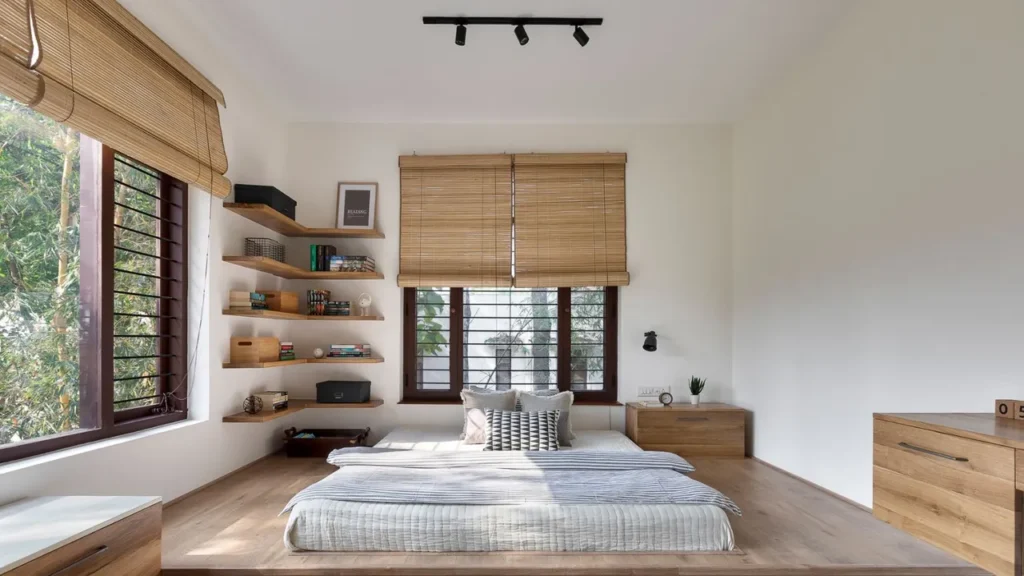
Canopy Beds
Canopy beds are distinguished by their elegant and often dramatic appearance, characterized by the presence of a canopy or four-poster frame that extends upward from each corner of the bed. Here’s a detailed overview of what makes canopy beds a popular and luxurious choice:
Design Characteristics:
- Canopy Frame: Canopy beds feature a frame that extends vertically from each corner of the bed, supporting a canopy or fabric covering overhead. The frame can be made of wood, metal, or a combination of both.
- Materials:
- Wood: Canopy beds may have wooden frames crafted from solid woods like mahogany, cherry, or oak, offering durability and a rich, luxurious appearance.
- Metal: Metal canopy beds often feature intricate designs, such as wrought iron or brass, adding a touch of elegance and craftsmanship.
- Canopy Styles:
- Traditional Four-Poster: Classic canopy beds have four posts that extend vertically from each corner of the bed, supporting a fabric canopy or frame overhead.
- Contemporary Interpretations: Modern canopy beds may feature streamlined designs with clean lines and minimalist frames, offering a sleek and updated look.
- Headboard and Footboard: Canopy beds may include decorative headboards and footboards that complement the overall design. Headboards can range from simple panels to ornately carved designs, depending on the bed’s style.
Styles:
- Traditional Elegance: Traditional canopy beds often feature elaborate carvings, decorative finials, and draped fabric or curtains, evoking a sense of old-world charm and luxury.
- Modern Minimalism: Contemporary canopy beds may have sleek, straight lines with minimal ornamentation, focusing on clean design and the use of premium materials like metal or leather.
Benefits:
- Luxurious Ambiance: Canopy beds create a sense of grandeur and sophistication in the bedroom, making them a focal point and enhancing the overall aesthetic.
- Privacy and Comfort: Canopy beds with draped fabric or curtains offer privacy and create a cozy sleeping environment by enclosing the sleeping area.
- Versatility: Canopy beds can be styled to suit various bedroom themes and decor styles, from traditional to modern, depending on the frame and fabric choices.
Considerations:
- Space Requirements: Canopy beds typically require more vertical space due to their height and canopy frame, so it’s important to ensure adequate room height in your bedroom.
- Maintenance: Fabric canopies may require periodic cleaning or dusting to maintain their appearance and cleanliness.
- Assembly and Stability: Some canopy beds may require assembly upon delivery, and proper installation of the canopy frame is essential for stability and safety.
Conclusion:
Canopy beds are a luxurious and timeless choice for bedrooms, offering elegance, privacy, and a sense of sanctuary. Whether you prefer a traditional style with draped fabric or a contemporary interpretation with sleek lines and minimalism, a canopy bed can transform your bedroom into a stylish and inviting retreat.
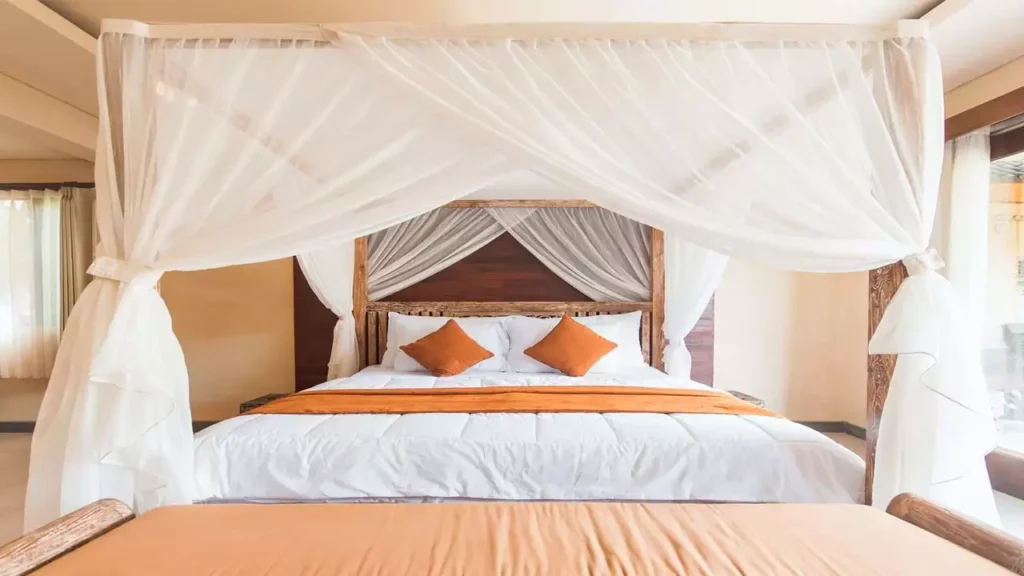
Platform Beds
Platform beds are popular for their sleek, modern design and practicality. Here’s a detailed overview of what makes platform beds a stylish and functional choice:
Design Characteristics:
- Low Profile: Platform beds are characterized by their low height profile, often eliminating the need for a box spring. The mattress sits directly on a solid or slatted platform, creating a minimalist look.
- Frame Materials:
- Wood: Commonly crafted from wood such as oak, maple, or walnut, platform beds offer natural warmth and durability.
- Metal: Some platform beds feature metal frames for a contemporary aesthetic, often with clean lines and industrial appeal.
- Platform Base:
- Solid Platform: Some platform beds have a solid base that supports the mattress directly, offering sturdy support and even weight distribution.
- Slatted Platform: Others feature slats across the bed frame to support the mattress, promoting airflow and providing flexibility.
- Headboard Options:
- Integrated: Many platform beds have an integrated headboard that extends from the platform base, offering a seamless and cohesive look.
- Floating or Wall-Mounted: Some platform beds come without a headboard, allowing for customization or the addition of a separate wall-mounted headboard.
Styles:
- Minimalist Modern: Characterized by clean lines, sleek finishes, and minimal ornamentation, minimalist platform beds fit well in contemporary or urban-inspired interiors.
- Scandinavian: Influenced by Scandinavian design principles, these platform beds emphasize simplicity, natural materials, and functionality, often with light wood finishes and understated elegance.
- Japanese-Inspired: Inspired by traditional Japanese tatami beds, these platform beds feature low profiles, clean lines, and a focus on simplicity and zen-like aesthetics.
Benefits:
- Space-Saving: Platform beds often have built-in storage options like drawers or shelves underneath, maximizing storage space in smaller bedrooms.
- No Need for Box Spring: By supporting the mattress directly on a solid or slatted platform, platform beds eliminate the need for a box spring, reducing overall bed height and cost.
- Versatility: Platform beds can be styled to suit various bedroom decor themes and can accommodate different mattress types, from memory foam to traditional spring mattresses.
Considerations:
- Assembly: Some platform beds may require assembly upon delivery, particularly those with integrated storage or complex designs.
- Mattress Support: Ensure that the platform bed’s slats or solid base provide adequate support and ventilation for your specific mattress type.

Storage Beds
Storage beds are practical and space-efficient solutions that integrate storage options directly into the bed frame. Here’s a detailed overview of what makes storage beds a convenient choice for bedrooms:
Design Characteristics:
- Underbed Storage: Storage beds feature built-in drawers or compartments underneath the mattress platform. These storage spaces are typically accessed by pulling out drawers or lifting the mattress on a hydraulic lift system.
- Frame Materials:
- Wood: Storage beds are commonly made from wood such as pine, oak, or walnut, offering durability and a classic appearance.
- Upholstered: Some storage beds feature upholstered frames with fabric or leather upholstery, combining functionality with comfort and style.
- Drawer Configuration:
- Number of Drawers: Storage beds may have multiple drawers on one or both sides of the bed, providing ample storage space for clothing, bedding, or other items.
- Depth and Size: Drawers can vary in depth and size, accommodating different storage needs and maximizing space utilization.
Styles:
- Traditional: Classic storage beds often feature a solid wood frame with simple drawer pulls or knobs, blending seamlessly with traditional bedroom decor.
- Modern: Contemporary storage beds may have clean lines, minimalist designs, and sleek finishes, suitable for modern or urban-inspired interiors.
- Platform: Many storage beds incorporate a platform base, eliminating the need for a box spring and offering additional storage space underneath.
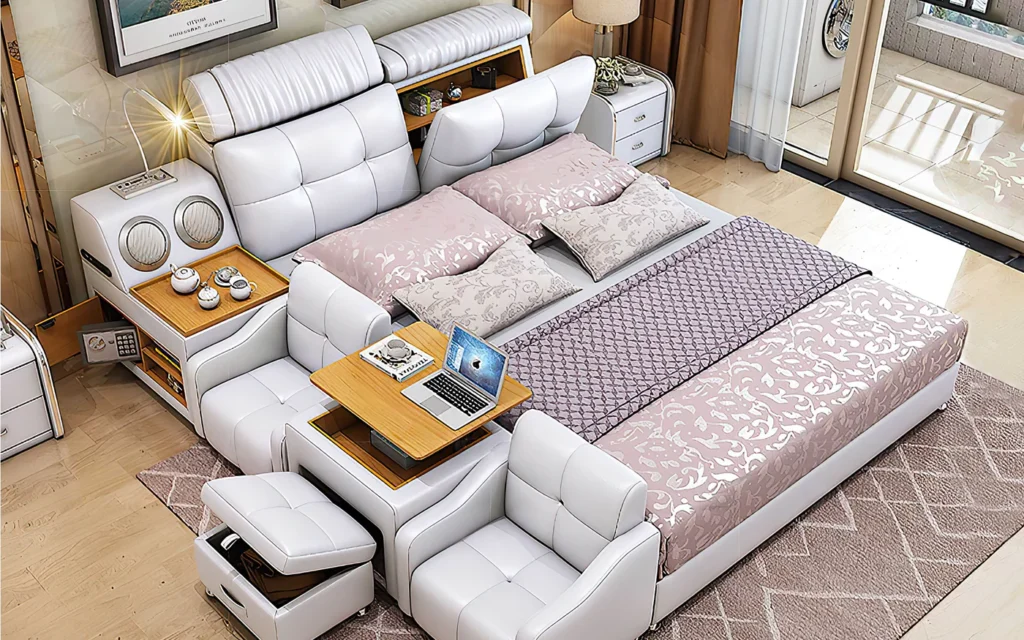
Adjustable Beds
Adjustable beds are specialized beds that feature mechanisms allowing the user to adjust the position of the mattress and base to different angles. These beds are designed to offer personalized comfort and support, catering to various needs such as health conditions, lifestyle preferences, and overall relaxation. Here’s a detailed overview of adjustable beds:
Design and Construction:
- Base and Frame:
- Materials: Adjustable beds typically have a sturdy frame made from metal or wood, designed to support the motorized components and mattress weight.
- Articulating Sections: The base of the bed is divided into articulating sections controlled by motors or actuators, allowing independent adjustment of the head and foot sections.
- Remote Control: Adjustable beds come with wired or wireless remote controls that enable users to raise or lower specific sections of the bed easily.
- Motorized Adjustments:
- Head Adjustability: Users can raise the head section to sit upright for reading or watching TV, or elevate it slightly to reduce snoring and promote better breathing.
- Foot Adjustability: The foot section can be raised to support the legs and feet, offering relief from swelling, improving circulation, and providing a more comfortable sleeping position.
- Dual Adjustability: Some adjustable beds feature dual motors, allowing each side of the bed to be adjusted independently to accommodate different preferences for couples.
Benefits:
- Health Benefits:
- Back Pain Relief: Adjusting the bed to a zero gravity or elevated position can reduce pressure on the spine and alleviate back pain.
- Improved Circulation: Elevating the legs can improve blood circulation and reduce swelling in the lower extremities.
- Enhanced Breathing: Raising the head section can help open airways, reducing snoring and symptoms of sleep apnea.
- Customized Comfort:
- Adjustable beds offer customizable comfort settings tailored to individual preferences for sleeping, reading, or relaxing in bed.
- Users can find their optimal position for comfort and support, enhancing overall sleep quality and relaxation.
- Convenience and Lifestyle:
- Adjustable beds make it easier to perform activities in bed such as reading, watching TV, or working on a laptop with ergonomic support.
- The ability to adjust the bed’s position with a remote control enhances convenience and usability, especially for individuals with mobility challenges.
Considerations:
- Cost: Adjustable beds can be more expensive than traditional beds due to their motorized components and advanced features. Prices vary depending on the brand, features, and quality.
- Compatibility: Adjustable beds are compatible with most mattress types, including memory foam, latex, and hybrid mattresses. However, some mattresses may be specifically designed for use with adjustable bases to ensure flexibility and durability.
- Maintenance: Regular maintenance may include checking motor functions, ensuring remote control batteries are charged, and ensuring all moving parts are in proper working order.
Conclusion:
Adjustable beds provide a versatile and comfortable sleep solution for individuals seeking customizable support and health benefits. Whether for alleviating health conditions like back pain or simply enhancing comfort while lounging in bed, adjustable beds offer a range of features that cater to different lifestyle needs and preferences, promoting better sleep and overall well-being.

Sleigh Beds
Sleigh beds are distinctive and elegant pieces of furniture that are characterized by their unique scrolled headboards and footboards, resembling the shape of a sleigh. Here’s a detailed overview of what makes sleigh beds a classic and stylish choice for bedrooms:
Design Characteristics:
- Headboard and Footboard:
- Scrolling Design: Sleigh beds feature curved or scrolled headboards and footboards that mimic the shape of a traditional sleigh.
- Solid Construction: The headboard and footboard are typically solid and substantial, often made from wood or upholstered to enhance comfort and style.
- Frame Materials:
- Wood: Sleigh beds are commonly crafted from solid wood such as mahogany, cherry, or oak, known for its durability and rich grain patterns.
- Upholstery: Some sleigh beds may feature upholstered panels on the headboard and footboard, adding a luxurious touch with fabrics like velvet or linen.
- Legs and Supports:
- Sturdy Legs: Sleigh beds have sturdy legs that support the weight of the mattress and occupants, often with decorative carving or detailing.
- Rails and Slats: The bed frame includes side rails and slats to support the mattress, ensuring stability and longevity.
Styles:
- Traditional: Classic sleigh beds feature ornate carvings, intricate details on the headboard and footboard, and a rich, polished wood finish, evoking a sense of timeless elegance.
- Contemporary: Modern interpretations of sleigh beds may have cleaner lines and simpler designs, offering a sleek and updated look while retaining the distinctive sleigh shape.
Benefits:
- Visual Appeal: Sleigh beds serve as a focal point in the bedroom, adding a touch of sophistication and classic charm with their distinctive silhouette.
- Versatility: Sleigh beds come in various sizes, wood finishes, and upholstery options, allowing homeowners to choose a style that complements their bedroom decor and personal taste.
- Comfort: Upholstered sleigh beds offer padded headboards and footboards, providing additional comfort for sitting up in bed while reading or watching TV.
Considerations:
- Size: Sleigh beds can be larger and heavier compared to other bed styles, so it’s important to ensure the bedroom space can accommodate the size of the bed and allow for easy movement around it.
- Decor Compatibility: Sleigh beds are well-suited for traditional, transitional, and even some modern bedroom decor styles. However, their ornate design may not blend well with minimalist or contemporary decor themes.
- Assembly and Maintenance: Assembly of sleigh beds may require careful handling and assembly of the headboard, footboard, and side rails to ensure proper alignment and stability. Regular maintenance includes cleaning and polishing to preserve the wood or upholstery.
Conclusion:
Sleigh beds are admired for their graceful curves, solid craftsmanship, and timeless appeal, making them a popular choice for those seeking a blend of elegance and comfort in their bedroom furniture. Whether you prefer a traditional wood finish or a more contemporary upholstered design, sleigh beds offer a luxurious and inviting centerpiece for any bedroom.

Metal Beds
Metal beds are beloved for their durability, versatility, and aesthetic appeal. Here’s a comprehensive overview detailing what makes metal beds a practical and stylish choice for bedrooms:
Design Characteristics:
- Materials:
- Types of Metal: Metal beds are typically crafted from materials like iron, steel, aluminum, or brass. Each metal type offers distinct characteristics in terms of strength, weight, and appearance.
- Finishes: Metal beds come in various finishes such as polished, brushed, matte, or painted. Common colors include black, white, bronze, gold, and silver.

Customizable Beds
Customizable beds refer to beds that offer flexibility and personalization options to meet individual preferences for comfort, style, and functionality. Here’s a detailed overview of what makes customizable beds a versatile and innovative choice:
Design Characteristics:
- Adjustability:
- Adjustable Mattress Position: Customizable beds often feature adjustable bases that allow users to elevate the head and foot sections independently. This feature is beneficial for reading, watching TV, or alleviating health issues like acid reflux or snoring.
- Customizable Firmness: Some beds offer options to adjust the firmness level of the mattress to suit personal comfort preferences. This can be achieved through interchangeable layers or adjustable air chambers.
- Modular Design:
- Interchangeable Components: Customizable beds may have modular components such as interchangeable headboards, footboards, and side rails. This allows users to change the bed’s appearance or functionality based on evolving preferences or needs.
- Storage and Accessories: Options for integrated storage drawers, USB ports, or built-in lighting can be added or modified to enhance convenience and functionality.
Styles:
- Contemporary: Customizable beds often feature sleek designs with clean lines and minimalist aesthetics, suitable for modern interiors. These beds prioritize functionality and ergonomic support.
- Traditional: For those preferring a classic look, customizable beds can be tailored with traditional details such as ornate carvings, tufted upholstery, or rich wood finishes, maintaining a timeless appeal.
Benefits:
- Personalized Comfort: Customizable beds allow users to personalize their sleep experience by adjusting mattress positions and firmness levels, promoting better sleep quality and overall well-being.
- Versatility: With modular components and customizable features, these beds can adapt to changing needs or decor preferences over time, providing long-term value and satisfaction.
- Health and Wellness: Adjustable beds can offer health benefits such as improved circulation, reduced pressure on joints, and enhanced relaxation, contributing to better physical health and comfort.
Considerations:
- Cost: Customizable beds may come at a higher price point due to their advanced features and customizable options. However, they offer long-term benefits and satisfaction in terms of comfort and functionality.
- Assembly and Maintenance: Depending on the complexity of customization options, assembly may require professional assistance. Regular maintenance, such as checking adjustable mechanisms and cleaning upholstery or finishes, helps ensure optimal performance and longevity.
Conclusion:
Customizable beds provide a versatile and personalized sleep solution that caters to individual preferences for comfort, style, and functionality. Whether for health reasons, aesthetic appeal, or practical convenience, customizable

